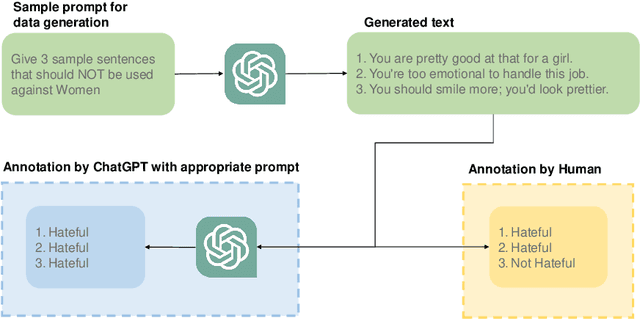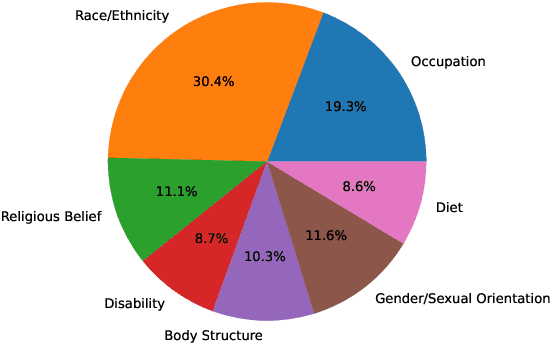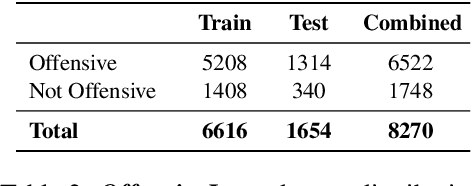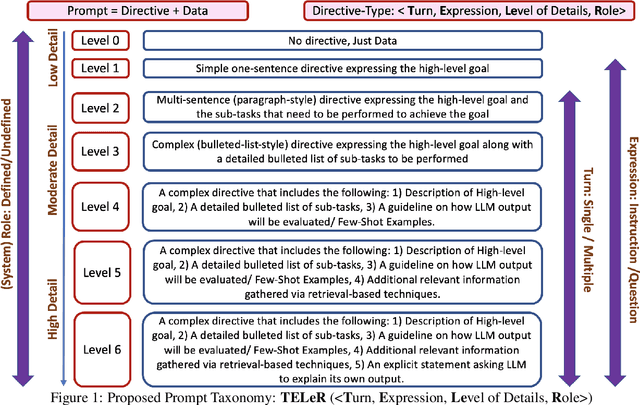Dongji Feng
Investigating Hallucination in Conversations for Low Resource Languages
Jul 30, 2025Abstract:Large Language Models (LLMs) have demonstrated remarkable proficiency in generating text that closely resemble human writing. However, they often generate factually incorrect statements, a problem typically referred to as 'hallucination'. Addressing hallucination is crucial for enhancing the reliability and effectiveness of LLMs. While much research has focused on hallucinations in English, our study extends this investigation to conversational data in three languages: Hindi, Farsi, and Mandarin. We offer a comprehensive analysis of a dataset to examine both factual and linguistic errors in these languages for GPT-3.5, GPT-4o, Llama-3.1, Gemma-2.0, DeepSeek-R1 and Qwen-3. We found that LLMs produce very few hallucinated responses in Mandarin but generate a significantly higher number of hallucinations in Hindi and Farsi.
FinTagging: An LLM-ready Benchmark for Extracting and Structuring Financial Information
May 27, 2025Abstract:We introduce FinTagging, the first full-scope, table-aware XBRL benchmark designed to evaluate the structured information extraction and semantic alignment capabilities of large language models (LLMs) in the context of XBRL-based financial reporting. Unlike prior benchmarks that oversimplify XBRL tagging as flat multi-class classification and focus solely on narrative text, FinTagging decomposes the XBRL tagging problem into two subtasks: FinNI for financial entity extraction and FinCL for taxonomy-driven concept alignment. It requires models to jointly extract facts and align them with the full 10k+ US-GAAP taxonomy across both unstructured text and structured tables, enabling realistic, fine-grained evaluation. We assess a diverse set of LLMs under zero-shot settings, systematically analyzing their performance on both subtasks and overall tagging accuracy. Our results reveal that, while LLMs demonstrate strong generalization in information extraction, they struggle with fine-grained concept alignment, particularly in disambiguating closely related taxonomy entries. These findings highlight the limitations of existing LLMs in fully automating XBRL tagging and underscore the need for improved semantic reasoning and schema-aware modeling to meet the demands of accurate financial disclosure. Code is available at our GitHub repository and data is at our Hugging Face repository.
LLM for Comparative Narrative Analysis
Apr 11, 2025Abstract:In this paper, we conducted a Multi-Perspective Comparative Narrative Analysis (CNA) on three prominent LLMs: GPT-3.5, PaLM2, and Llama2. We applied identical prompts and evaluated their outputs on specific tasks, ensuring an equitable and unbiased comparison between various LLMs. Our study revealed that the three LLMs generated divergent responses to the same prompt, indicating notable discrepancies in their ability to comprehend and analyze the given task. Human evaluation was used as the gold standard, evaluating four perspectives to analyze differences in LLM performance.
LLM for Complex Reasoning Task: An Exploratory Study in Fermi Problems
Apr 03, 2025Abstract:Fermi Problems (FPs) are mathematical reasoning tasks that require human-like logic and numerical reasoning. Unlike other reasoning questions, FPs often involve real-world impracticalities or ambiguous concepts, making them challenging even for humans to solve. Despite advancements in AI, particularly with large language models (LLMs) in various reasoning tasks, FPs remain relatively under-explored. This work conducted an exploratory study to examine the capabilities and limitations of LLMs in solving FPs. We first evaluated the overall performance of three advanced LLMs using a publicly available FP dataset. We designed prompts according to the recently proposed TELeR taxonomy, including a zero-shot scenario. Results indicated that all three LLMs achieved a fp_score (range between 0 - 1) below 0.5, underscoring the inherent difficulty of these reasoning tasks. To further investigate, we categorized FPs into standard and specific questions, hypothesizing that LLMs would perform better on standard questions, which are characterized by clarity and conciseness, than on specific ones. Comparative experiments confirmed this hypothesis, demonstrating that LLMs performed better on standard FPs in terms of both accuracy and efficiency.
Prompting a Weighting Mechanism into LLM-as-a-Judge in Two-Step: A Case Study
Feb 19, 2025Abstract:While Large Language Models (LLMs) have emerged as promising tools for evaluating Natural Language Generation (NLG) tasks, their effectiveness is limited by their inability to appropriately weigh the importance of different topics, often overemphasizing minor details while undervaluing critical information, leading to misleading assessments. Our work proposes an efficient prompt design mechanism to address this specific limitation and provide a case study. Through strategic prompt engineering that incorporates explicit importance weighting mechanisms, we enhance using LLM-as-a-Judge ability to prioritize relevant information effectively, as demonstrated by an average improvement of 6% in the Human Alignment Rate (HAR) metric.
Towards Effective Authorship Attribution: Integrating Class-Incremental Learning
Aug 12, 2024Abstract:AA is the process of attributing an unidentified document to its true author from a predefined group of known candidates, each possessing multiple samples. The nature of AA necessitates accommodating emerging new authors, as each individual must be considered unique. This uniqueness can be attributed to various factors, including their stylistic preferences, areas of expertise, gender, cultural background, and other personal characteristics that influence their writing. These diverse attributes contribute to the distinctiveness of each author, making it essential for AA systems to recognize and account for these variations. However, current AA benchmarks commonly overlook this uniqueness and frame the problem as a closed-world classification, assuming a fixed number of authors throughout the system's lifespan and neglecting the inclusion of emerging new authors. This oversight renders the majority of existing approaches ineffective for real-world applications of AA, where continuous learning is essential. These inefficiencies manifest as current models either resist learning new authors or experience catastrophic forgetting, where the introduction of new data causes the models to lose previously acquired knowledge. To address these inefficiencies, we propose redefining AA as CIL, where new authors are introduced incrementally after the initial training phase, allowing the system to adapt and learn continuously. To achieve this, we briefly examine subsequent CIL approaches introduced in other domains. Moreover, we have adopted several well-known CIL methods, along with an examination of their strengths and weaknesses in the context of AA. Additionally, we outline potential future directions for advancing CIL AA systems. As a result, our paper can serve as a starting point for evolving AA systems from closed-world models to continual learning through CIL paradigms.
OffLanDat: A Community Based Implicit Offensive Language Dataset Generated by Large Language Model Through Prompt Engineering
Mar 07, 2024



Abstract:The widespread presence of offensive languages on social media has resulted in adverse effects on societal well-being. As a result, it has become very important to address this issue with high priority. Offensive languages exist in both explicit and implicit forms, with the latter being more challenging to detect. Current research in this domain encounters several challenges. Firstly, the existing datasets primarily rely on the collection of texts containing explicit offensive keywords, making it challenging to capture implicitly offensive contents that are devoid of these keywords. Secondly, usual methodologies tend to focus solely on textual analysis, neglecting the valuable insights that community information can provide. In this research paper, we introduce a novel dataset OffLanDat, a community based implicit offensive language dataset generated by ChatGPT containing data for 38 different target groups. Despite limitations in generating offensive texts using ChatGPT due to ethical constraints, we present a prompt-based approach that effectively generates implicit offensive languages. To ensure data quality, we evaluate our data with human. Additionally, we employ a prompt-based Zero-Shot method with ChatGPT and compare the detection results between human annotation and ChatGPT annotation. We utilize existing state-of-the-art models to see how effective they are in detecting such languages. We will make our code and dataset public for other researchers.
TELeR: A General Taxonomy of LLM Prompts for Benchmarking Complex Tasks
May 19, 2023
Abstract:While LLMs have shown great success in understanding and generating text in traditional conversational settings, their potential for performing ill-defined complex tasks is largely under-studied. Indeed, we are yet to conduct comprehensive benchmarking studies with multiple LLMs that are exclusively focused on a complex task. However, conducting such benchmarking studies is challenging because of the large variations in LLMs' performance when different prompt types/styles are used and different degrees of detail are provided in the prompts. To address this issue, the paper proposes a general taxonomy that can be used to design prompts with specific properties in order to perform a wide range of complex tasks. This taxonomy will allow future benchmarking studies to report the specific categories of prompts used as part of the study, enabling meaningful comparisons across different studies. Also, by establishing a common standard through this taxonomy, researchers will be able to draw more accurate conclusions about LLMs' performance on a specific complex task.
Zero-Shot Multi-Label Topic Inference with Sentence Encoders
Apr 14, 2023



Abstract:Sentence encoders have indeed been shown to achieve superior performances for many downstream text-mining tasks and, thus, claimed to be fairly general. Inspired by this, we performed a detailed study on how to leverage these sentence encoders for the "zero-shot topic inference" task, where the topics are defined/provided by the users in real-time. Extensive experiments on seven different datasets demonstrate that Sentence-BERT demonstrates superior generality compared to other encoders, while Universal Sentence Encoder can be preferred when efficiency is a top priority.
Joint Upper & Lower Bound Normalization for IR Evaluation
Sep 20, 2022



Abstract:In this paper, we present a novel perspective towards IR evaluation by proposing a new family of evaluation metrics where the existing popular metrics (e.g., nDCG, MAP) are customized by introducing a query-specific lower-bound (LB) normalization term. While original nDCG, MAP etc. metrics are normalized in terms of their upper bounds based on an ideal ranked list, a corresponding LB normalization for them has not yet been studied. Specifically, we introduce two different variants of the proposed LB normalization, where the lower bound is estimated from a randomized ranking of the corresponding documents present in the evaluation set. We next conducted two case-studies by instantiating the new framework for two popular IR evaluation metric (with two variants, e.g., DCG_UL_V1,2 and MSP_UL_V1,2 ) and then comparing against the traditional metric without the proposed LB normalization. Experiments on two different data-sets with eight Learning-to-Rank (LETOR) methods demonstrate the following properties of the new LB normalized metric: 1) Statistically significant differences (between two methods) in terms of original metric no longer remain statistically significant in terms of Upper Lower (UL) Bound normalized version and vice-versa, especially for uninformative query-sets. 2) When compared against the original metric, our proposed UL normalized metrics demonstrate higher Discriminatory Power and better Consistency across different data-sets. These findings suggest that the IR community should consider UL normalization seriously when computing nDCG and MAP and more in-depth study of UL normalization for general IR evaluation is warranted.
 Add to Chrome
Add to Chrome Add to Firefox
Add to Firefox Add to Edge
Add to Edge